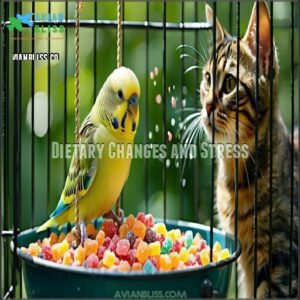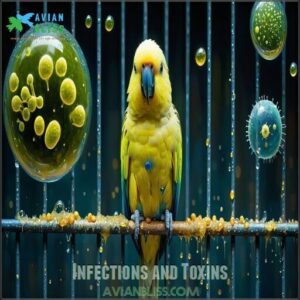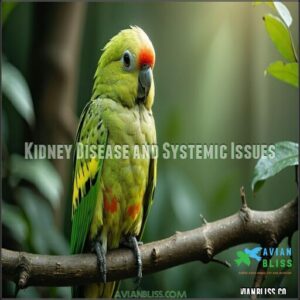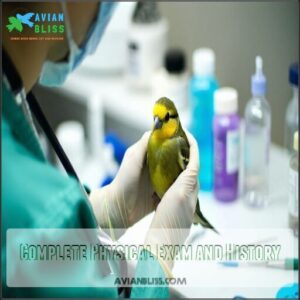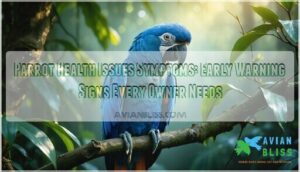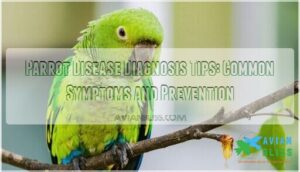This site is supported by our readers. We may earn a commission, at no cost to you, if you purchase through links.
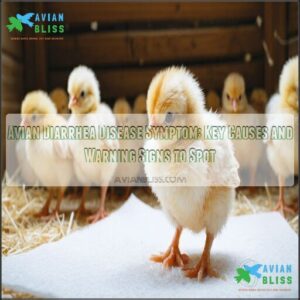
Weight loss and signs of dehydration are other key indicators.
Keep an eye out for ruffled feathers, straining during poop time, or swelling around their head.
Purple coloring on their wattles, combs, or legs? That’s another red flag.
Remember, diarrhea can signal infections or parasites. Spotting these signs early is super important.
Want to learn how to tell normal poop from the not-so-normal kind? There’s more to discover!
Table Of Contents
- Key Takeaways
- Avian Diarrhea Overview
- Causes of Avian Diarrhea
- Diarrhea Diagnosis Methods
- Avian Diarrhea Treatment Options
- Specific Avian Gastrointestinal Diseases
- Frequently Asked Questions (FAQs)
- What causes avian diarrhea?
- How do I know if my bird has diarrhea?
- What causes diarrhea in birds?
- What are the symptoms of bacterial infections in birds?
- Is diarrhea a common clinical presentation in birds?
- How do you know if a bird has a gastrointestinal illness?
- How do you know if your bird has diarrhea?
- What does my birds poop look like when it’s sick?
- What are the symptoms of avian gastric yeast infection?
- Does my bird have diarrhea?
- Conclusion
Key Takeaways
- You’ll suspect avian diarrhea if you see frequent, watery droppings, appetite loss, or lethargy in your bird.
- You can identify abnormal droppings by increased liquid volume, inconsistent consistency, undigested food, or unusual colors.
- You’ll find that dietary changes, infections, toxins, and stress are common causes of avian diarrhea.
- You’ll need fecal tests, blood work, and a physical exam by a vet to diagnose the cause and get proper treatment for your bird.
Avian Diarrhea Overview
When your bird’s droppings change from their normal appearance, it’s often a sign of underlying health concerns.
Understanding what typical droppings look like and recognizing abnormalities helps you take quick action to protect your bird’s well-being.
Normal Dropping Composition
Normal droppings are a detailed map of your bird’s health.
Normal droppings are like a health report card for your bird. They offer key insights into their well-being.
They’re made up of green or brown feces, white urates, and clear urine.
Dropping consistency, urine volume, and urates appearance can vary slightly, depending on diet and species variation.
Regularly inspecting your bird’s feces helps spot changes early, safeguarding avian health. Understanding what normal looks like keeps you in control of your bird’s well-being and peace of mind.
Abnormal Droppings Identification
Spotting abnormal droppings is like reading the tea leaves of your bird’s health—they reveal a lot.
When droppings shift from the norm, you may spot these red flags:
- Volume Increase: Excess liquid points to watery droppings in birds.
- Consistency Changes: Diffuse edges signal trouble.
- Undigested Food: A digestive red alert.
- Color Significance: Odd hues might signal an underlying cause.
- Odor Analysis: A stronger smell could indicate avian diarrhea.
Regularly check for consistent color changes to help identify potential health issues.
Early detection promotes effective diarrhea diagnosis in birds!
Warning Signs of Health Issues
Now that you know what’s not normal, let’s look at the concerning signs. Your bird’s droppings can reveal health secrets.
Avian diarrhea warning signs demand your attention.
Dropping color changes can signal internal issues. Mucus presence suggests an infection risk. Undigested food points to digestive trouble. Increased dropping frequency indicates a systemic problem.
Watch for these red flags, like appetite loss or watery droppings, to catch avian disease symptoms early.
Causes of Avian Diarrhea
You’re probably wondering what’s making your bird’s droppings look a little "off," and it’s important to know that many factors can contribute to avian diarrhea.
We’ll explore common culprits, like sudden diet changes, nasty infections, and even exposure to toxins, so you can better understand what might be upsetting your feathered friend’s system.
Dietary Changes and Stress
Now that you understand normal droppings, let’s see how diet and stress can upset your bird’s tummy!
Avian diarrhea often starts with unexpected things.
Here’s what can cause poultry diarrhea:
- Sudden Food Shifts
- High-Sugar Diets
- Rapid Changes
- Nutritional Imbalances
- Environmental Stressors
These dietary changes and stress can turn your happy bird into a stressed-out patient with bird diarrhea.
Infections and Toxins
If stress has weakened your bird, now bacterial infections, fungal overgrowth, and viral impact can overwhelm them.
Toxins are everywhere. Metal toxicity and other toxin exposure pose risks.
Your bird’s droppings reveal dangerous infections, like Salmonella. These infections and toxins are diarrhea causes birds.
Newcastle Disease Virus can also have a severe viral impact.
Spot these threats early. This helps you catch signs of avian diarrhea before they become life-threatening.
Kidney Disease and Systemic Issues
Beyond infections and toxins, kidney disease can really mess with your bird’s health.
Kidney troubles can really throw a bird’s system off balance, leading to issues like changes in their droppings.
If your feathered friend’s kidney function is compromised, it disrupts fluid balance and urate levels. This can trigger systemic effects, like polyuria and abnormal droppings.
Treatment focuses on managing uric acid buildup. It also supports organ function and prevents further kidney damage.
Veterinary interventions help maintain overall kidney function and address avian diarrhea.
Dietary changes, such as increased fruit consumption, can also impact droppings.
Diarrhea Diagnosis Methods
So, you’ve noticed your bird’s droppings aren’t quite right, and you’re probably wondering what’s going on.
You’ll need to understand the methods vets use to figure out what’s causing the diarrhea, from checking for parasites to looking at blood work and even X-rays.
Fecal Tests and Parasite Identification
When your bird has diarrhea, fecal tests are key for parasite identification.
Your avian vet will use fecal microscopy for parasite detection. They’re hunting for microscopic clues!
Here’s what to expect:
- Carefully collected droppings under a clinical lens
- Microscopic examination for tiny invaders
- Culture tests revealing hidden pathogens
- Detailed tracking of protozoal life-cycles
Early Giardia identification prevents complications.
Fecal tests help diagnose Trichomoniasis and Roundworms.
Worm egg count and coccidia screening are important.
You can find products for avian fecal testing online.
Proper hygiene aids in avian parasite prevention.
We’re on the case!
Blood Work and Imaging Studies
After those fecal tests, what’s next?
Your vet might order blood work, including a CBC analysis, to check your bird’s overall health.
Imaging studies come next.
| Test | What It Shows | Why It’s Done |
|---|---|---|
| Radiographs | Bone and organ size/shape | Detect masses, organ issues |
| Ultrasound Use | Soft tissues | Check organ texture, fluid |
| Endoscopy Procedures | Direct view of organs | Biopsy analysis, foreign bodies |
These tests help with avian diarrhea diagnosis, guiding treatment through careful lab work and radiograph interpretation.
Complete Physical Exam and History
After blood work and imaging, your vet will do a complete physical exam.
Skilled Exam Techniques and Palpation Findings help uncover hidden avian diarrhea indicators.
Evaluating your sick bird symptoms, feather quality, and behavior, a vet’s expertise reveals underlying issues that numbers alone can’t expose.
Auscultation Results, Owner Observations, and History Importance during physical exams are part of veterinary care.
This complete physical exam is key.
Avian Diarrhea Treatment Options
So, your feathered friend’s got the runs; what’re you gonna do?
You’ll discover that treatment options range from medications targeting infections to dietary adjustments and supportive care, all aimed at getting your bird back to its healthy, happy self.
Medication for Infections
Once your vet identifies the infection, they’ll likely prescribe antibiotics.
Dosage Precision is key; too little, and you risk the infection persisting, too much, and you promote Resistance Management.
For protozoal invaders, antiparasitic drugs are the go-to. If it’s yeast, antifungal medications are needed.
There are many Antibiotic Types and Antifungal Options available. Some birds may require ivermectin for parasites.
Always heed professional guidance to help guarantee a safe and effective treatment, minimizing medication side-effects.
Remember, the right medication at the right dose is your bird’s best shot at a swift recovery.
Dietary Changes and Supportive Care
Often, dietary changes are your first defense against avian diarrhea. Here’s how to help:
- Introduce new foods slowly.
- Offer digestible foods.
- Use hydration methods, like electrolyte solutions.
- Incorporate probiotics for gut health.
For personalized nutritional guidance during recovery, consult your avian vet.
Supplementing with essential bird nutrients can also aid recovery. Probiotic use, balanced nutrition, and supportive care are key.
Remember, a warm environment aids recovery.
Reducing Stress and Improving Immune Health
After diet changes, let’s talk stress and immune health.
Environmental factors are key! For bird diarrhea, minimizing stress is key.
Minimize changes, and try enrichment activities.
Boost immune health with probiotics. Many owners find introducing helpful bacteria can improve their bird’s gut health.
Addressing avian anxiety helps recovery.
| Factor | Benefit | Action |
|---|---|---|
| Sleep Quality | Boosts immune function | Assure 10-12 hours of rest |
| Social Interaction | Reduces stress | Provide companionship |
| Sunlight Exposure | Enhances vitamin D | Offer supervised time outside |
| Limit Overcrowding | Minimizes disease spread | Keep cages spacious |
Specific Avian Gastrointestinal Diseases
You’ve learned about diarrhea’s causes and treatments, but did you know specific diseases target a bird’s gut?
We’ll explore some common culprits, like avian gastric yeast and Giardia, and what you can do about them. Complete concepts
Macrorhabdus Ornithogaster Infection
Let’s explore another cause of avian diarrhea. You mightn’t know, but Macrorhabdus Ornithogaster, an avian gastric yeast, can cause Macrorhabdosis. It’s also called Megabacteria.
Here’s what you should know:
- Megabacteria Symptoms include weight loss.
- Transmission Routes often involve fecal contamination.
- Diagnosis Challenges arise because not all birds show signs.
- Treatment Efficacy varies, but antifungals help.
- Prevention Strategies involve strict hygiene.
If you see signs of bird diarrhea, consult your vet!
Candida Albicans Infection
After dealing with Macrorhabdus, keep an eye out for Candida Albicans.
This yeast can cause fungal infections. You’ll want to watch for Candida Symptoms.
- White plaques in the mouth?
- Sudden weight loss?
- Crop stasis?
- Changes in droppings?
Diagnosis Challenges exist, so, get quick vet help.
Treatment Options include antifungals and probiotics.
Prevention Strategies involve good hygiene. Remember, a strong Immune Response is key.
Act fast to manage Candida Albicans and prevent avian diarrhea from this gastrointestinal illness.
Psittacine Herpesvirus Infection
After yeast infections, let’s examine Psittacine Herpesvirus.
You don’t want this "viral wolf" causing avian diarrhea!
Herpesvirus Transmission occurs via oral and fecal routes. It causes papillomas, and serious health issues.
:
—:
:
—:
Watch for Feather Dusting.
Latency Periods mean carriers shed the virus. Quarantine prevents viral transmission. Vaccine Development is ongoing. The Immune Response varies.
Giardia Protozoa Infection
After herpesvirus, another issue can emerge: Giardia.
This protozoa spreads through Giardia transmission from infected droppings, causing giardiasis and malabsorption.
Oral antiparasitic medications aid in treatment.
Watch for these Giardia Symptoms:
- "Popcorn" droppings.
- Itching.
- Weight loss.
For Giardia diagnosis, your vet can prescribe targeted Giardia treatment to halt this gastrointestinal parasites invasion and restore your bird’s health.
Preventing Giardia involves good hygiene.
Trichomoniasis and Roundworms Treatment
For trichomoniasis and roundworms, prompt action is key.
Here’s how you can help:
- Administer Trichomoniasis medication, like metronidazole.
- Use Roundworm dewormers, such as antiparasitic medication.
- Monitor treatment and seek veterinary care.
- Implement preventative measures, like hygiene.
- Assess the potential for resistance development.
Supportive therapy is essential.
Don’t let avian diarrhea win!
Remember, early action can save your bird.
Frequently Asked Questions (FAQs)
What causes avian diarrhea?
Did you know smaller birds are more prone to it?
You’ll find dietary changes and stress can cause it.
Also, infections and toxins might be the culprits.
Nutritional imbalances could be a factor, too. Also
How do I know if my bird has diarrhea?
You’ll know your bird has diarrhea if you spot frequent, watery droppings.
Look for appetite loss, lethargy, and weight loss.
Also, watch for color changes, mucus, or undigested food in the droppings.
What causes diarrhea in birds?
Did you know smaller birds are more prone to diarrhea?
You’ll find that dietary changes, infections, stress, and toxins often cause it.
Nutritional imbalances and underlying health issues can also trigger diarrhea in your bird.
What are the symptoms of bacterial infections in birds?
You’ll see frequent, watery droppings if your bird has a bacterial infection.
Also, watch for appetite loss, lethargy, weight loss, dehydration, and signs of pain.
Don’t wait; a vet visit is essential.
Is diarrhea a common clinical presentation in birds?
Did you know diarrhea affects smaller birds more?
Yes, it’s a common sign something’s up with your bird.
You’ll notice frequent, watery droppings, appetite loss, and maybe some lethargy.
Watch for color changes, too, as these signs need vet attention.
How do you know if a bird has a gastrointestinal illness?
You’ll notice changes in droppings, like unusual colors or undigested food.
Keep an eye out for appetite loss, lethargy, or vomiting.
These signs suggest a gastrointestinal illness, needing a vet’s attention.
How do you know if your bird has diarrhea?
Ah, diarrhea, the bane of bird owners!
You’ll know your bird has diarrhea if you see frequent and watery droppings.
Watch for appetite loss, lethargy, and weight loss, too.
Don’t ignore these signs; your feathered friend needs your help!
What does my birds poop look like when it’s sick?
If your bird is sick, you’ll see increased liquid volume in their droppings.
Watery edges, undigested food, or unusual colors are also signs.
Inconsistent consistency means it’s time to check with your vet.
What are the symptoms of avian gastric yeast infection?
Imagine finding undigested seed in your bird’s droppings. You’ll also notice vomiting, weight loss, and emaciation. Avian gastric yeast can cause these symptoms, so consult your vet.
Does my bird have diarrhea?
You’ll see frequent, watery droppings if your bird has diarrhea.
Watch for appetite loss, lethargy, or weight loss.
Dehydration, plus signs of pain, could mean it’s time for a vet visit.
Conclusion
Imagine your parrot, usually chatty, is now quiet with messy droppings.
Recognizing an avian diarrhea disease symptom early is key.
You’ve learned key signs, from watery poop to appetite loss. Now, you understand potential causes like infections or dietary changes.
Don’t delay! Quick diagnosis, through fecal tests or blood work, is essential. With proper treatment, your feathered friend will be back to their old self in no time.


